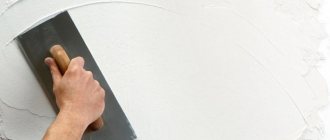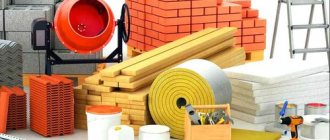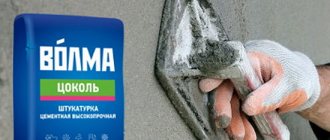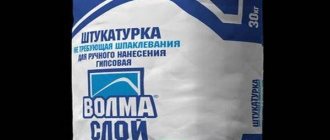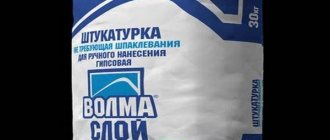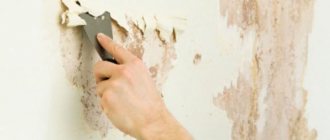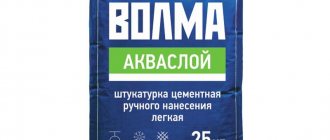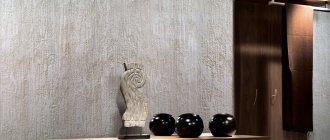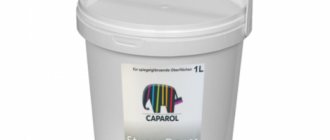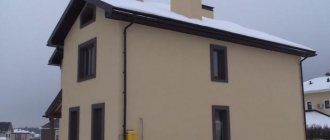In appearance, Volma “Layer” plaster is a white mixture in powder form, where the gypsum base is the main binder. In addition, the plaster contains polymer fillers that have a positive effect on the adhesive properties of the diluted solution.
Moisture resistance and impact resistance also increase. The properties imparted by special components begin to work when the mixture is diluted and continue to work during its further use.
Instructions for dilution and application.
The preparation of Volma “Layer” gypsum plaster begins with studying the instructions. Here are essentially the usual steps; it is important to follow the proportions indicated on the packaging. To 1 kilogram of the composition add 600-700 milliliters of liquid. Considering that Volma gypsum plaster is packaged in 30 kg craft bags, it turns out that we need 18-21 liters of water per package.
To begin, pour some water into a convenient container (preferably plastic, it’s easier to work with) to wet the bottom and walls. The mixture is poured to the exact ratio of water according to the proportions. Mixing can be done using a trowel or trowel, but it is much more convenient (much easier for large volumes) to use a construction mixer or a trill with a special attachment. Tools will significantly save time and effort for quality work.
After stirring once, let the solution sit for about 3-5 minutes, this is the period of maturation of the components. After time has passed, stir the diluted mixture again until lumps are completely removed. The consistency should resemble thick sour cream, be plastic, but at the same time not flow off the instrument.
The gypsum composition in question can be used for minor repairs and major interior finishing. The limitation is due to the fact that gypsum, by its nature, absorbs moisture very well, so applying such plaster outdoors is a bad option.
The diluted composition is excellent for: plastering plasterboard, cellular concrete, reinforced concrete slabs, brick and wood.
This plaster is used for:
- restoration work, when minor defects are eliminated;
- minor repairs to level surfaces;
- capital finishing, when work is done from scratch;
- as a finishing coating for leveling before grouting with a sponge float
- creating decorative elements, arches, reliefs or sculptures.
After applying the finishing coat, immediately begin painting or laying ceramic tiles; surfaces coated with Volma “Layer” plaster allow this to be done.
Remember the recommendations on the packaging; the work room should be dry with a temperature range of 5-30 degrees above zero.
Note: If Volma gypsum plaster is applied in rooms with high humidity, then treat it with protective compounds. Do not allow water to come into direct contact with the plaster.
Summary
As you can see, gypsum plaster is an excellent tool for leveling surfaces. Based on user reviews, it is clear that working with it is much easier than with sand-cement mortars. The plasticity of gypsum plaster is simply amazing. If such work is being carried out for the first time, then it is better to mix gypsum plaster in small portions.
Recommended Posts
Decorative plaster
Composition of mixtures for plastering walls
Plastering a brick wall with your own hands
Plastering walls under wallpaper
Decorative plaster mosaic
Aligning walls with beacons
Preparing the wall.
You must first prepare the base for applying Volma plaster, otherwise you will get a bad result.
- Remove dust and dirt.
- Remove any remaining paint and loose pieces of plaster.
- Smooth out cracks and chips.
- Check the evenness of the wall with a level.
- If necessary, install leveling beacon profiles.
- Treat metal objects that are part of the base with an anti-corrosion agent.
Volma “Layer” gypsum plaster is applied to the bases manually using a standard set of tools:
- Different sized spatulas.
- Trowels made of different materials.
- Rule and falcon.
- Leveling floats.
The instructions indicate how to use Volma plaster with the listed tools. It is not worth diluting a lot of gypsum mixture at once, since the hardening period of the gypsum is 20-30 minutes. Calculate how much area you will have time to process during this time and, based on the consumption of Volma “Layer” plaster per 1 m2, mix the solution.
Application sequence.
Leveling - having thrown the composition onto the wall, they begin to level it using a broad rule using beacons or without them when the wall is more or less even). The rule is from bottom to top, removing all excess and placing it on the recesses.
Trimming is carried out when the gypsum structure has set (after an hour) and acquired hardness. Similar to leveling, the rule cuts off small irregularities in individual areas, directing them into the remaining recesses. Already at this stage you can finish with plaster if your goal is to decorate with wallpaper or tiles. Remember to prime the surface before proceeding with the next type of work.
Smoothing is done with a grater with a sponge surface. It is recommended to start 20 minutes after trimming. After moistening the base with water, begin to move the grater over it until a “milk” forms.
You will immediately feel it when it appears, the friction will increase significantly and it will become more difficult to drive the tool. The resulting substance fills the microcavities and evens out the lunges.
Glossing is the final stage of processing. Here a grater with a metal plane is used. Essentially, the remaining defects on the gypsum surface are rubbed and compacted.
Maintain the full drying time indicated in the instructions; it depends on the temperature and ventilation of the room.
Carrying out markings.
To prevent problems and facilitate such a process as laying tiles on plaster, it is advisable to mark control points in advance and set beacons. This technique is recommended during plastering work, as well as when laying tiles on any surface.
The layout diagram is the first step. To do this, all available options are depicted schematically and to scale. After which it is possible to transfer the diagram directly to the wall, taking into account the need to create a small space between the tiles for the seams.
To carry out the correct marking, it is necessary to resort to the help of tools such as plumb lines and a building level, marking row lines on the wall. As a rule, the starting row is the second bottom row. This is done in order to preserve intact tiles at the top of the wall.
Having thus determined the line of the first row, it is necessary to secure a parallel support bar. This will help maintain the level and prevent further sliding of the tiles under their own weight. It is possible to use both wooden planks and metal profiles.
Decor on the surface.
You can decorate in different ways, from simple wallpapering to complex techniques of painting on dry plaster. It all depends on your preferences.
- The relief and texture can be set by special rollers. You can also even apply a relief pattern that can be selected on the roller rotor.
- The texture is also set with a simple spatula, alternately pressing on the weakly set gypsum solution. It turns out very beautiful.
- Decorative plaster can make many dreams come true, having a huge selection of options.
- Having the talent of an artist, take up your brushes and paints, create unique and inimitable patterns.
Important! Proceeding to the next stage after applying the plaster, be it wallpaper or tiles. Be sure to saturate the surface with primer, otherwise all your work will go down the drain. The primer will increase the adhesion of surfaces.
Tool for the job
To plaster manually (it does not matter with what composition), classical and modern tools are used.
So, to prepare the mixture you will need:
- a construction mixer (if you don’t have one, you can use an electric drill with an attachment for mixing);
- Master OK;
- spatula (for removing unstirred mixture from the walls of the container).
To dilute the dry mixture, take plastic containers that must be clean and dry. The volume depends on the speed of production of the gypsum solution (the experience of the plasterers, their quantity); for a beginner plastering alone, at first a basin of up to 60 liters will be enough. You will also need a container of water (bucket) in which to wash the mixer attachment after use.
For preparatory work:
- spatulas and other tools for removing old coating;
- roller, brush (for priming);
- spatula for repairing cracks and chips;
- level (for checking the verticality of the wall, installing beacons), preferably a laser one;
- cords and plumb line (if there is no laser level).
Directly used for plastering:
- Master OK
- rule (h-shaped for leveling, trapezoidal for trimming);
- sponge grater (use a tool to “soak” and polish);
- spatula (wide);
- ironing board
Spatulas and a smoothing iron must have a stainless steel working part.
To refine the surface, textured/structural rollers and other devices can be used.
You will also need:
- pencil (for marking);
- masking tape;
- film (to protect adjacent surfaces, frames and glass);
- roulette;
- garbage bags;
- stepladder or scaffolding;
- carrying to control (using an angular light) surface quality;
- clean rags.
Specifications.
The diluted composition has:
- excellent adhesion;
- excellent vapor permeability, which affects air movement in the room;
- environmental friendliness - the basis is natural gypsum;
- no shrinkage.
The presence of good technical characteristics in Volma gypsum plaster has a positive effect on quality. Distinctive characteristics:
- working thickness from 5 to 30 millimeters;
- completion of setting within 3-4 hours;
- complete hardening within a week.
Undoubtedly, everyone has noticed that applying Volma Layer plaster to walls is very simple; you can do it yourself without resorting to the services of repair crews. This will significantly save your budget.
Advantages of Volma layer
Environmental friendliness
The plaster does not contain heavy metals or other chemical components that are harmful to human health. This property of the Volma layer allows it to be used in residential premises and children's rooms.
Economical
It is possible to achieve a perfectly flat surface with a sufficiently thin layer of the composition; it does not require additional treatment with other putty materials due to the glossy surface. Low consumption - an average of 8.5 kg of dry mixture per 1 sq.m. Average price with quality guaranteed by the manufacturer.
Multifunctionality
Can be used to prepare the surface for a variety of finishing works: for tiles, wallpaper, painting. There are options for casting relief finishing elements or performing decorative types of plaster.
Plaster consumption.
Of course, material consumption depends on the curvature of the wall and the thickness of the layer. But, by default, based on the consumption of Volma plaster per 1 m2 with a layer thickness of 1 cm, you will need about 7.5 -9 kilograms.
It is not at all necessary to rely and take this as a basis, because there can be many factors influencing consumption. In order to avoid the mistakes of others, spend a little time on forums about Volma plaster where there are probably reviews about working with it.
Recommendation: Volma “Layer” gypsum plaster is purchased with a small reserve; this action will protect you in future from going to the store again when you are faced with minor surface modifications.
The role of the primer.
The importance of pre-applying a primer solution before directly laying the tiles is explained by the ability of this mixture to have a beneficial effect on the properties of the surface. Gypsum plaster under tiles using a primer provides the most effective result. Thus, penetrating into the structure of the surface coating and creating a protective film on it, the primer allows:
- Significantly reduce porosity;
- Creates a water-repellent and impermeable film, thereby preventing moisture from entering;
- Significantly increases the strength of the coating;
- Improves the adhesion of building materials, resulting in increased adhesive properties;
- Helps strengthen the gypsum layer so that it remains stable even with increased load on it;
- Strengthens protection against fungus.
Other mixtures from the manufacturer.
Volma “Aquaslayer” plaster is a lighter fibrous composition with the presence of Portland cement, polymers and natural components. Like the composition we are considering, it is intended for leveling bases. Already from the name one can judge that it is hydrophobic and can be used in wet areas. Cement plaster Volma "Aquasloy" is used both inside buildings and on their exterior facade.
Compositions with a cement binder are often used as a primary layer, which serves as a reliable base:
- laying ceramic tiles;
- putty and decoration.
There are practically no restrictions on covering bases with Aqualayer; it can be cellular concrete, reinforced concrete products, floor slabs, wooden walls. Volma cement plaster “Aquaslayer” is packaged in 25 kg craft bags.
Conclusions and comparisons.
When you come to a construction site to buy finishing materials, your head is spinning from the wide variety.
Without knowing exactly what to choose, you can get confused. The most popular plasters are “Knauf” and “Volma”. Which gypsum plaster is better, “Knauf” or “Volma”, read on the forums in reviews of ordinary citizens and professional builders. data-matched-content-ui-type=”image_stacked” data-matched-content-rows-num=”2″ data-matched-content-columns-num=”3″ data-ad-format=”autorelaxed”>
